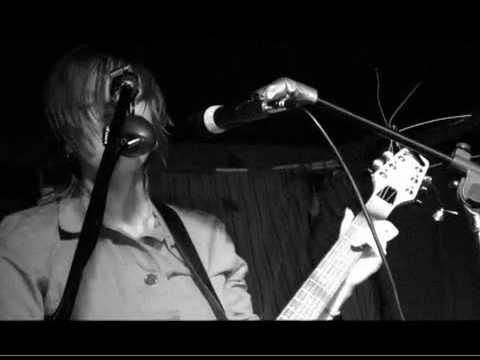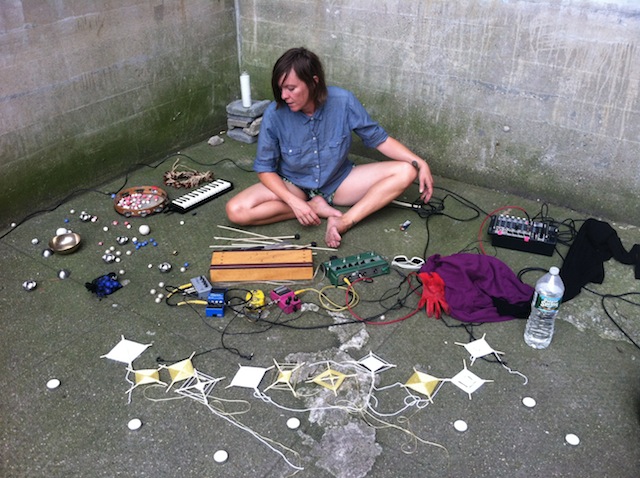By Elisabeth Wilson & Clea Partridge for Tom Tom Magazine
Name: Tara Jane O’Neil
Age: 41
Hometown: Louisville, KY
Lives In: Los Angeles
Past Bands: Rodan, Retsin, The Sonora Pine, The King Cobra, and Drinking Woman
Current Bands: TJO
Set up/gear: 24 inch wind gong, 18 inch frame drum, 52 inch frame drum, sculpey balls, wooden beads, salt bowls, metal singing bowls, electric tambourine, silverware, screwdriver, electric toothbrush, small metal vibrator, slit box, kit when i can.
Sticks/mallets: rubber ball mallets, fuzzy white mallets, steel brushes, hot rods.
In Louisville, Kentucky in the early 2000s, Tara Jane O’Neil was a significant figure in the city’s surprisingly vibrant art and music scene. She is associated with a long list of bands, particularly the ‘90s band Rodan, which was considered, among the people I knew there, one of the most important Louisville indie hardcore bands. As a solo artist, O’Neil has released seven albums internationally, formed the Ecstatic Tambourine Orchestra, and played with Mount Eerie, The Naysayer, Come, Mirah, Ida, Sebadoh, Jackie-O Motherfucker, Michael Hurley, Papa M, and Amy Ray. Although TJO, as she is sometimes called, is widely known as a guitarist in the singer/songwriter genre, she is also a percussionist, a composer, and visual artist. She has scored films, theater and dance performances, and written large and small ensemble experimental architectures.
Sometimes, she says, her guitar is a percussive instrument (especially when she jams tambourine cymbals and tiny sticks or knives into the strings and strikes it with small rubber mallets). She has always played lots of instruments, including percussion. “I played my brother’s silver sparkle Slingerland drum kit when I was a kid. I’ve played kit and other percussion on all my solo records. And occasionally, I get to play kit and percussion in other people’s bands (back in the day, Sebadoh, and more recently Little Wings, Key Losers, Mirah, and others).”
Using simple objects as percussion, she says, is how she can be most expressive and free. Her favorite object instrument is made of two hand sized metal singing bowls, a dozen small metal salt bowls, and large and small balls made of polymer clay. “It’s called the big bang,” she says, “and it’s got pretty small but resonant sounds—the roll of the ball, the strike of ball against bowl, and the sustained tone of the miracle metal. It’s kind of like a chime machine.”
An electric toothbrush on a spring drum, a vibrator on an Autoharp, an electric tambourine—she thinks of these as Stone Age tools, which she prefers to modern instruments like [the music production software] Ableton or synthesizers. “So I bang around with objects looking for the color or the chaos or whatever is missing.”
Vibrations and how they affect humans is a fascination of hers. The gong, she says, “with its complexity of overtones and undertones and harmonics and just plain power, is a semi conductor, a radio tower, a lightning rod, a spaceship.”
Her choice of fairly small but resonant and non-traditional percussion instruments is indicative of the kind of performance environments she gravitates to. O’Neil prefers gallery spaces and non-traditional venues to bars or Rock clubs. It’s important to her to find really spectacular venues, preferring things outside or spaces where that kind of environmental transformation can happen. “It invites the audience to feel OK within the space.”
I asked her about the difference between performance in Louisville, Portland, Los Angeles, and other places she’s performed. She says Japan is her favorite place to play. “I can do improvisation with a person playing a noodle bowl and her feet, and take a break, then move into a song set. And it’s all good and fine. And it sometimes gets to happen in a 400-year-old temple.”
O’Neil names collaboration as the common thread that runs through all her years of work. In August of 2012, she performed her graphic score composition Sev Entrain with Rachel Carns, Leah Cippola, Kanako Pooknyw, Lisa Schonberg, and Heather Treadway at Portland’s music venue and art space, Holocene. From an audience perspective, the performance was like stumbling across some ancient, magical ceremony happening by the light of a bonfire. It began as O’Neil and the other performers sat shoulder to shoulder in a tight circle facing outward, emitting tonal exhales, interpreting O’Neil’s visual score, which was based on various systems of metaphysics and rehearsal conversations and discoveries. The sensation was a cross between a mournful wail and a deep release.
When asked to discuss the performance, O’Neil said, “It was an experiment in entertainment, or falling into each other’s rhythms and vibes. Also, it was an experiment in composing a graphic score to be interpreted and changed by the players. Not a total improvisation—a little like a cult band, a little like a rock band, but neither. Tactile listening and intuitive sounding.”
There are a million things, TJO says, that are special about percussion, compared to other instruments. On her new record there is a song for just frame drum and voice that expresses her particular interest in elemental music. “Making music with our bodies is super exciting to me,” she says. “Percussion as foot on ground or skin on skin is elemental.”
O’Neil has a full-length album of songs coming out January 27th on Kranky Records, with tours in the US, Japan and Europe in the spring. In 2014 she’ll release the improvisational/experimental sound and percussion based music she’s done for dance performances and films.



